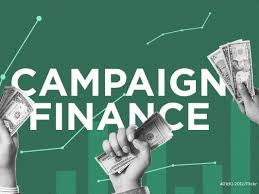Millions Raised And Spent To Sway Indiana Voters In 2020 Election
By LaMonte Richardson Jr.
TheStatehouseFile.com
INDIANAPOLIS— In a year when candidates spent enormous sums on competitive races, overall spending in statewide contests was down by almost half from the last presidential election year.
Although final reports will not be released until early 2021, the $64 million raised statewide in contributions is a stark comparison to the more than $121 million raised during the 2016 election cycle. In most races, the candidate with more spending power prevailed.
Governor’s raceÂ
In the 2020 gubernatorial race, Republican Gov. Eric Holcomb raised nearly $4 million in comparison to Democratic candidate Woody Myers’ $1.27 million, combining for $5.23 million. This is far less than the $8.7 million that was raised in the annual 2016 election cycle by Holcomb and Democratic candidate John Gregg.

“In 2016 the Democratic candidate was coming off a narrow loss in 2012 and already had a fundraising base for 2016 and was able to generate a whole lot more money than 2020 candidates,†said Indiana University Purdue University Fort Wayne professor Andrew Downs.
“In this year part of what made it difficult was the same thing that’s made everything else difficult, and that’s the pandemic.â€
In the 2020 Hoosier gubernatorial race, Holcomb received large donations from Eli Lilly, Simon properties owner Herbert Simon, and Republican lobbyist Richard F. Hohlt. Holcomb even received $50,000 from Rally Health Inc. founder and United Health Chief Digital Officer Grant Verstandig. The largest of his contributions came from the Republican Governors Association, totaling up to $500,000.
Common Cause Policy Director Julia Vaughn who has been following campaign finance issues at the Statehouse for more than two decades, said such large contributions from individuals and Political Action Committees drown out the voices of everyday Hoosiers.
“Giving significant contributions to political candidates is something a very tiny percentage of Hoosiers do. Those who often fund political campaigns are the first in line when candidates get elected and have a much easier time gaining access to candidates in making their views heard,†Vaughn said.
Holcomb’s principle competitor, Woody Myers, used a reported $269,000 of his own money, according to the campaign finance reports filed with the Secretary of State’s office. Myers received one of his largest individual contributions of $100,000 from Indianapolis environmental activist Mary Bookwalter.
The difference in the amount of campaign cash raised by the two leading candidates was a significant obstacle for Myers to overcome. Downs attributed this to Holcomb winning over voters from Myers by his handling of COVID-19.
“The way Gov. Holcomb handled the pandemic made people think he was handling it in a reasonable fashion and it was not necessary to go looking for alternative candidates,†said Downs. It also made some Democrats reasonably comfortable and “made them believe that they did not need to back the Democratic candidate as heavily.â€

The two recorded more than a combined $9.1 million in expenditures. Holcomb spent the majority of the money at more than $7.9 million and Myers recorded $1.2 million. Holcomb started with a balance of $7.2 million before raising an additional $4 million to allow him to spend $7.9 million.
Holcomb spent nearly $5.1 million on ad placement through Target Enterprises LLC, a California-based media company that specializes in providing media planning, media buying and media products. An additional $436,172 was spent on video production and consulting done by Pittsburgh-based BrabenderCox LLC.
Myers spent $36,176 of his dollars on media production by Jensen Productions and Angela Cain Communications. He spent $10,942 on Facebook advertisements, where he did most of his campaigning. Myers also contributed nearly $100,000 to Donnelly for IN for a reported email list.
As one would assume by the spending numbers alone, Holcomb won in a landslide. Holcomb collected 56.5% of Hoosier votes to Myers’ 32.1%.
Attorney GeneralÂ
In the Indiana attorney general’s race between Democrat Jonathan Weinzapfel and Republican Todd Rokita, a total of $3.2 million was reported in contributions and nearly $2.5 million in spending.
Weinzapfel raised $1.3 million and spent a total of over $1.5 million due to his starting balance of over $600,000. Weinzapfel spent over half his total with Armour Media and Blue West media, totaling at over $873,000 between the two.

Rokita raised more than $1.8 million and spent $936,000 in the 2020 election cycle. In Rokita’s campaign, more than $678,000 was spent with Littlefield Consulting Services in Washington D.C. Littlefield Consulting is a full service campaign and public policy firm that works with mostly Republican candidates. Rokita ultimately received more money from the Republicans Attorney General Association Action Fund than he spent in the entire 2020 election cycle, taking in more than $925,000.
Vaughn cited the political action committee money from the attorneys general group as an example of the kind of outside funding that are no good for Indiana politics.
Downs said that RAGA put so much money behind Rokita because the PAC understands the roles attorney generals are playing in policy right now as the law firms of the states.
“Over the last 10 to 15 years we have seen attorney generals file lawsuits about the Affordable Care Act, they have filed lawsuits about abortion legislation, they have filed lawsuits about things that are considered as policy legislation,†Downs said. “The desire is to get as many of those on your side as you can get.â€
Weinzapfel received contributions from the Democratic Attorney General Association Indiana which added up to more than $38,000, far less than what Rokita received from the Republicans. He also received large contributions such as $75,000 from Indiana/Kentucky/Ohio Regional Council of Carpenters and $25,000 from Indiana Ironworks.
Rokita defeated Weinzapfel in the race, earning 58.3% of votes to Weinzapfel’s 41.7%.
House District 88Â
In District 88 in northeast Indianapolis, Republican Chris Jeter and Democrat Pam Dechert combined for nearly $447,000 in contributions. Jeter raised the majority of the money reporting $362,990 and Dechert raising $83,905 in contributions.
Jeter also spent nearly 10 times what Dechert reported in expenditures. He spent $337,000 in comparison to Dechert’s $35,000, eventually winning the race with 59.3% of votes.
House District 15Â
In northwest Indiana, Republican Harold Slager and Democrat Chris Chyung, the first-term incumbent, raised more than $220,000 in contributions during the 2020 election cycle. Chyung raised $132,582, moderately more than Slager’s near $89,578.
Slager’s beginning balance of more than $40,328 helped him spend more than $96,000 and secured a win with 51.5% of votes in comparison to Chyung’s 48.5%, despite Chyung spending more, $131,250.64.
House District 35
In District 35 west of Muncie, Republican Elizabeth Rowray and incumbent Democrat Melanie Wright raised more than $300,000 in the 2020 election cycle. The victor, Rowray raised nearly three times more than Wright—nearly $225,000 in comparison to Wright’s near $78,000.
Wright had a beginning balance of $33,738 from previous campaigns and spent a total of $96,021, nearly $18,000 more than she reported in contributions. The money came from previous campaigns. Rowray spent more than $212,000, over double what Wright spent.
Senate District 30
In northern Indianapolis, Republican incumbent John Ruckelshaus and Democrat Fady Qaddoura reported more than $1.1 million in contributions combined.
Quaddoura started the 2020 election cycle with a beginning balance of $116,783 and reported $451,969 in contributions. Ruckelshaus started with a balance of $94,002 and raised an additional $666,000.
Quaddoura reported $487,644 in expenditures while Ruckelshaus reported $626,851. Quaddoura raised and spent less than Ruckelshaus, but walked away with 52.6% of the vote in comparison to Ruckelshaus’ 47.4%.
FOOTNOTE: LaMonte Richardson Jr. is a reporter for TheStatehouseFile.com, a news website powered by Franklin College journalism students.






